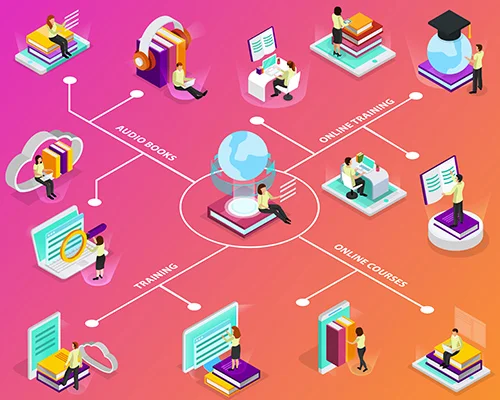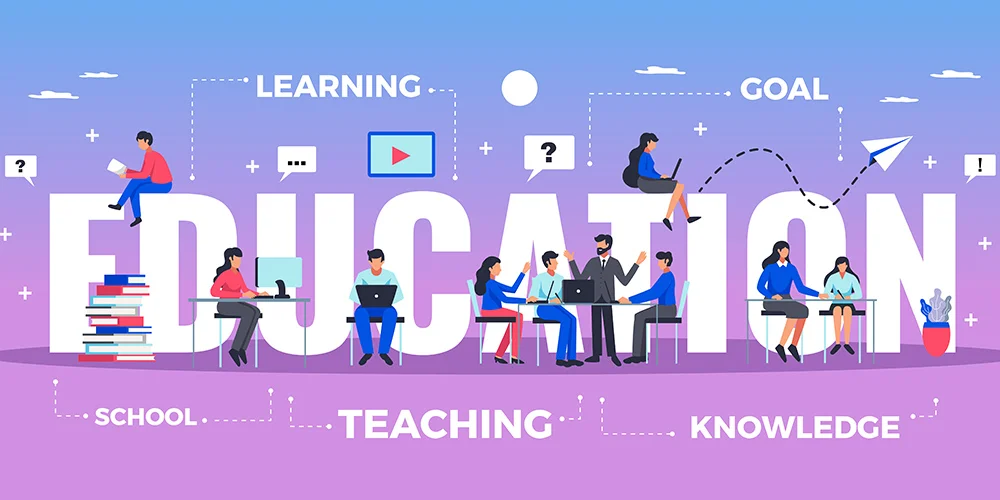Digital Education: also known as online education or e-learning, refers to the use of digital technologies, primarily the internet and various electronic devices, to deliver educational content and facilitate learning. It encompasses a wide range of educational practices and methods that leverage digital tools and resources to enhance the teaching and learning experience. Digital education can occur at all levels of education, from elementary schools to higher education and even professional development.
History of Digital Education
The history of digital education can be traced back to the early 20th century, but it gained significant momentum with the advent of computers and the internet.
Here’s an overview of key milestones in the history of digital education:
- 1920s – 1930s: The earliest forms of educational technology emerged with the use of radio and educational broadcasts. Radio was used to broadcast educational content to remote areas, reaching a broader audience.
- 1950s – 1960s: The development of computers during this period led to the creation of computer-assisted instruction (CAI). Early computer programs were used for drill-and-practice exercises in subjects like mathematics and language.
- 1970s – 1980s: The introduction of personal computers in schools and the development of educational software marked a significant shift. Programs like “Oregon Trail” and “Logo” became popular educational tools.
- 1990s: The World Wide Web emerged in the early 1990s, opening up new possibilities for digital education. Educational institutions began creating websites, and online courses and resources started to appear.
- 2000s: The 2000s saw the rise of Learning Management Systems (LMS) like Blackboard and Moodle, which allowed educators to manage and deliver content online. Open educational resources (OER) gained popularity, providing free access to educational materials.
- 2010s: Massive Open Online Courses (MOOCs) gained prominence, making high-quality courses from prestigious institutions accessible to a global audience. The use of mobile devices for learning increased, and personalized learning platforms began to emerge.
- 2020s: The COVID-19 pandemic accelerated the adoption of digital education as schools and universities worldwide had to quickly transition to online learning to ensure continuity of education. This period saw advancements in virtual classrooms, AI-driven adaptive learning, and increased emphasis on digital literacy.
Throughout this history, digital education has evolved from simple computer programs to complex, interactive online environments. It has expanded educational access, improved flexibility for learners, and provided new opportunities for educators to innovate in their teaching methods. Digital education continues to evolve, with emerging technologies like artificial intelligence, virtual reality, and augmented reality playing significant roles in shaping its future.

Types of Digital Education
Digital education encompasses various types and formats of online learning and educational technology.
Here are some common types of digital education:
- Online Courses: Online courses are formal educational programs delivered over the internet. They cover a wide range of subjects and are often offered by universities, colleges, and online learning platforms. These courses can be either synchronous (real-time) or asynchronous (self-paced).
- Massive Open Online Courses (MOOCs): MOOCs are online courses that are open to a large number of participants and are often provided by prestigious universities and institutions. They typically offer free access to course materials but may charge for certificates or credentials.
- Blended Learning: Blended learning combines traditional face-to-face instruction with online components. This approach allows students to access resources and participate in activities online while still engaging in in-person classroom sessions.
- Flipped Classroom: In a flipped classroom model, students learn content online before attending in-person classes, allowing class time to focus on discussions, projects, and hands-on activities.
- Virtual Classrooms: Virtual classrooms use video conferencing and collaboration tools to facilitate real-time interactions between students and instructors. These environments aim to replicate the traditional classroom experience online.
- Self-Paced Learning: Self-paced learning allows students to progress through course materials at their own speed. They have the flexibility to start, pause, and resume their studies as needed.
- Educational Apps: Mobile apps and software designed for educational purposes provide a convenient way for learners to access lessons, quizzes, and interactive content on smartphones and tablets.
- Open Educational Resources (OER): OER are freely accessible educational materials, including textbooks, videos, and course modules, that can be used, shared, and adapted by educators and students.
- Adaptive Learning: Adaptive learning platforms use algorithms and data analytics to personalize the learning experience for each student, adapting content and assessments based on individual progress and performance.
- Simulations and Virtual Labs: These digital tools allow students to experiment and explore concepts in a safe and virtual environment, particularly useful in science and engineering fields.
- Microlearning: Microlearning breaks down content into small, easily digestible modules or lessons, often lasting only a few minutes. It is designed for quick consumption and retention of information.
- Gamification and Serious Games: Gamification incorporates game elements like points, badges, and leaderboards into educational content to make learning more engaging. Serious games are games designed specifically for educational purposes.
- Professional Development and Training: Digital education is widely used in corporate settings for employee training and skill development. Online courses and webinars are commonly used for this purpose.
- Language Learning Apps: Dedicated apps and platforms help learners acquire foreign languages through interactive lessons, exercises, and immersion experiences.
- Coding and Programming Courses: Digital education is instrumental in teaching coding and programming skills, with numerous online resources and coding bootcamps available.
These are just a few examples of the types of digital education available today. The landscape of digital education is continually evolving with the advancement of technology and the changing needs of learners and educators.
Benefits of Digital Education
Digital education offers numerous benefits for learners, educators, and educational institutions.
Here are some of the key advantages of digital education:
- Accessibility: Digital education provides access to learning resources and opportunities regardless of geographic location. It breaks down barriers, making education available to individuals in remote areas and those with physical disabilities.
- Flexibility: Learners can access digital content and participate in online courses at their own pace and on their schedule. This flexibility is especially valuable for working professionals, parents, and individuals with busy lifestyles.
- Personalization: Digital education platforms often use data and analytics to tailor content to individual learner needs. This personalization can help students learn more effectively by addressing their strengths and weaknesses.
- Cost-Effective: Online courses and resources can be more cost-effective than traditional classroom-based education. Students can save on commuting, accommodation, and material costs.
- Diverse Learning Resources: Digital education offers a wide range of multimedia resources, including videos, interactive simulations, eBooks, and online libraries, enriching the learning experience.
- Immediate Feedback: Online assessments and quizzes can provide immediate feedback to students, helping them identify areas of improvement and reinforcing learning.
- Global Learning Community: Digital education connects learners with peers and instructors from around the world. This global perspective can enhance cultural awareness and foster collaboration.
- Lifelong Learning: Digital education encourages a culture of lifelong learning, allowing individuals to acquire new skills and knowledge throughout their careers.
- Reduced Environmental Impact: Online learning reduces the need for physical infrastructure, such as classrooms and printed materials, leading to a lower environmental footprint.
- Convenience: Learners can access digital educational materials from the comfort of their homes or any location with an internet connection, eliminating the need for commuting.
- Improved Access to Expertise: Students can learn from experts and instructors from around the world, expanding their exposure to diverse perspectives and knowledge.
- Scalability: Educational institutions can reach a larger audience through digital education, potentially serving more students with fewer resources.
- Real-World Skills: Many digital education programs focus on practical skills and real-world applications, preparing students for the demands of the job market.
- Time Efficiency: Online learning can be more time-efficient, as students can skip over material they already understand and focus on areas where they need more practice.
- Safety and Health: In times of crisis, such as the COVID-19 pandemic, digital education provides a safe alternative to in-person learning, ensuring continuity of education.
While digital education offers numerous benefits, it’s important to recognize that it also comes with challenges, such as the need for digital literacy, potential for social isolation, and concerns about data privacy. Effective implementation and ongoing improvement are essential to maximize the advantages of digital education while addressing its limitations.

What is the role of Digital Education?
Digital education plays several crucial roles in modern education systems, addressing various aspects of teaching, learning, and administration.
Its roles are multifaceted and can be summarized as follows:
- Facilitating Access to Education: Digital education removes geographical and physical barriers, making education accessible to learners in remote areas, individuals with disabilities, and those with limited access to traditional educational institutions.
- Enhancing Learning Experiences: It provides learners with a wide range of multimedia resources, interactive simulations, and engaging content that can improve comprehension and retention. Digital tools can cater to different learning styles and preferences, making learning more engaging and effective.
- Personalizing Learning: Digital education platforms often use data analytics and algorithms to personalize learning experiences. They can adapt content, assessments, and recommendations to the individual needs and progress of each learner, promoting better outcomes.
- Promoting Lifelong Learning: Digital education encourages a culture of continuous learning throughout one’s life, supporting ongoing skill development and adaptability in a rapidly changing job market.
- Supporting Different Learning Models: It accommodates various learning models, including self-paced learning, blended learning, flipped classrooms, and experiential learning, allowing educators to choose the most suitable approach for their students.
- Improving Assessment and Feedback: Digital tools enable automated grading, immediate feedback on assessments, and the tracking of student progress. This helps educators identify areas where students may be struggling and intervene accordingly.
- Globalizing Education: Digital education connects learners and educators from around the world, promoting cross-cultural understanding and collaboration. It facilitates the exchange of knowledge and perspectives on a global scale.
- Simplifying Administrative Tasks: Digital systems streamline administrative processes such as enrollment, scheduling, record-keeping, and reporting. This reduces administrative burden and allows institutions to allocate resources more efficiently.
- Supporting Professional Development: Digital education is used for ongoing professional development, helping educators stay up-to-date with new teaching methods and technologies.
- Enhancing Research and Collaboration: Digital tools and resources facilitate research and collaboration among educators and researchers. Online platforms make it easier to share findings and collaborate on projects.
- Improving Resource Management: Digital education allows educational institutions to optimize resource allocation, reduce costs associated with physical facilities, and increase the scalability of their programs.
- Ensuring Educational Continuity: In times of crisis, such as pandemics or natural disasters, digital education can ensure continuity of learning. It provides a means for students to continue their studies remotely when physical schools are not accessible.
- Addressing Skill Gaps: Digital education programs often focus on developing practical skills and competencies that are in demand in the job market. This helps bridge skill gaps and better prepare students for employment.
- Promoting Digital Literacy: Digital education inherently promotes digital literacy, equipping learners with the skills to navigate the digital landscape, critically evaluate information, and use technology effectively.
- Customizing Learning Pathways: Digital education allows learners to choose and customize their learning pathways, exploring topics of interest and pursuing their educational goals more flexibly.
Overall, the role of digital education is to leverage technology and digital tools to enhance the quality, accessibility, and efficiency of education. It supports both learners and educators in their pursuit of knowledge and skill development in a rapidly evolving digital age.
How effective is digital learning?
The effectiveness of digital learning can vary widely depending on various factors, including how it is implemented, the quality of digital resources, learner engagement, and individual preferences.
Here are some key points to consider when evaluating the effectiveness of digital learning:
- Effectiveness Varies: Digital learning can be highly effective when well-designed and thoughtfully implemented. However, it is not a one-size-fits-all solution, and its effectiveness may vary from one context to another.
- Quality of Content: The quality of digital learning content and materials is critical. High-quality resources that are engaging, interactive, and aligned with educational objectives are more likely to be effective.
- Learner Engagement: Learner engagement plays a crucial role in the effectiveness of digital learning. If learners are not motivated or actively participating, the effectiveness of digital education may be compromised.
- Pedagogical Design: Effective digital learning often involves careful pedagogical design, including the incorporation of active learning strategies, opportunities for collaboration, and meaningful assessments.
- Support and Guidance: Learners may require support and guidance to succeed in digital learning environments, particularly in self-paced or online courses. Effective support mechanisms, such as access to instructors or mentors, can enhance effectiveness.
- Digital Literacy: Learners need to be digitally literate to navigate digital learning platforms effectively. Training in digital literacy can improve the effectiveness of digital education.
- Technology Infrastructure: Access to reliable internet and suitable devices is essential for effective digital learning. Disruptions in technology infrastructure can hinder the learning experience.
- Assessment and Feedback: Effective assessment and timely feedback are crucial in digital learning. Well-structured assessments help learners gauge their understanding and progress.
- Alignment with Learning Objectives: Digital learning should be aligned with specific learning objectives and outcomes. When there is clear alignment, learners are more likely to achieve their educational goals.
- Interactivity and Adaptability: Highly interactive and adaptive digital learning environments can adjust content and activities based on individual learner needs, increasing effectiveness.
- Data Analytics: Data analytics can be used to monitor learner progress and identify areas where learners may be struggling. This data-driven approach can inform instructional adjustments.
- Continuous Improvement: Ongoing evaluation and improvement of digital learning programs are essential to address any shortcomings and make necessary adjustments to enhance effectiveness.
- Motivation and Self-Discipline: Learners in digital environments often need a high degree of motivation and self-discipline. The effectiveness of digital learning can be influenced by the learner’s ability to stay on track and manage their time effectively.
In summary, digital learning can be highly effective when designed and implemented thoughtfully, with attention to content quality, learner engagement, support mechanisms, and alignment with learning objectives. However, it is essential to recognize that its effectiveness can vary depending on the specific context and how well these factors are addressed. Like traditional education, the success of digital learning ultimately depends on a combination of factors and the commitment of both learners and educators to the learning process.
Internet of Things: (IoT) Benefits & Building The Urban Future





